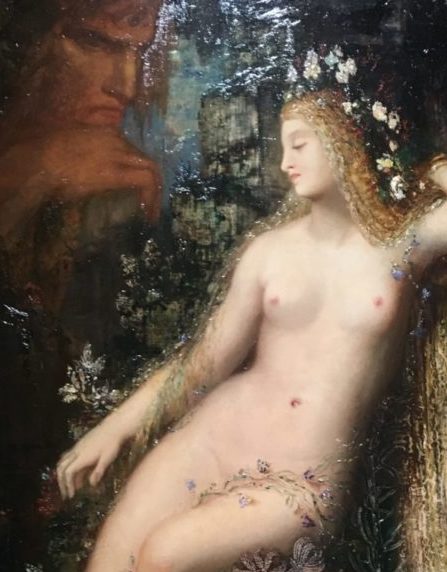Huysmans exhibitions at Musée D’orsay by Francesco Vezzoli: from Degas to Grunwald
Francesco Vezzoli, an Italian contemporary artist, who is compared to Jeff Koons or Ashley Bickerton, shows its exhibition on Huysmans at Musée D’Orsay. Vezzoli analyses the writer from his days as an art critic until his late conversion to Catholicism, and presents the stages of his career with three colours: white, red and black. These three colours normally represent innocence, passion (or lust in case of H.) and death but the black room celebrates the writer’s conversion instead.Before writing À Rebours, H. is interested in Zola’s naturalism; he wrote Marthe, story of a prostitute at that time declared will “I’m in favour of the art of dreams as much as of the art of reality”, Raffaëlli is as interesting as Odillon Redon for him.
With À Rebours H. abandoned naturalism and embrace decadentism. The first paintings in the White Room show an odd critic of art, referring to The Commode’s death, by Pelez, Huysmans wrote “J’avais tout d’abord mal compris le sujet, je pensais que le monsieur en caleçons de bais blanc était un masseur et que la femme soulevant le rideau disait simplement le bain est prêt”. In fact, the painting shows the Emperor’s slave on the point of dying. His description of the Birth of Venus by Bourgerau is also ironic: “il a inventé la painture gazeuse, la pièce soufflé. Ce n’est meme plus de la porcelaine, c’est du leché flasque; c’est je ne sais quoi, quelque chose comme de la cher molle de pulpe”, after these blunt words nobody will see the painting in the same way than before. The white room ends with “Rolla”, by Gervex. H. appreciates the painting, because of the man’s disdainful look on a woman who is lustfully lying in the centre. She is a courtesan. Whether or not she is a courtesan, the man seems by contrast a silly element of the picture, because he despises a beautiful body.
The red room is the most interesting one. The beautiful Galatée by Moreau stands in the middle of the room, it’s even more beautiful than Salome that Huysmans describes in is novel À Rebours. Salome the dancer, the goddess, the symbol of indestructible lust. H. also admires Degas’ dancers, but only L’Absinthe is showed. In the middle of the space, protected by a glass box, there’s the Des Essaintes’s turtle, fashioned for Vezzoli by the jewellery house, Bulgari. The animal “contains” D. E.’s neurosis, the same disease which has its ancestry in Barbay D’Aurevilly, Carriere, De la Gandara, whose portraits occupy part of the red wall. D. E., the protagonist of À Rebour, sets gems silver and gold on the shell of his turtle, and as a consequence the animal dies. Nature doesn’t survive to the overwhelming artifice, the decadent genious will kill what he creates.
About 20 drawings by O. Redon fill another wall, reminding us of Tim Burton’s atmosphere and characters, in front of them The Initiation by Rops “Diaboli virtus in lombis”.
The journey ends in the small but evocative black room which contains three copies of the same picture representing The Crucifixion by Grunewald, interpreted by Vezzoli.
A photo of Huysman reminds us that he lived in 11, rue de Sevrès, Paris, not far from the exhibition.
photo: credits Zelda

Thanks, this site is really beneficial.